All products featured are independently chosen by us. However, SoundGuys may receive a commission on orders placed through its retail links. See our ethics statement.
Apple AirPods Pro 3 vs AirPods 4: Big price gap, big differences
September 25, 2025
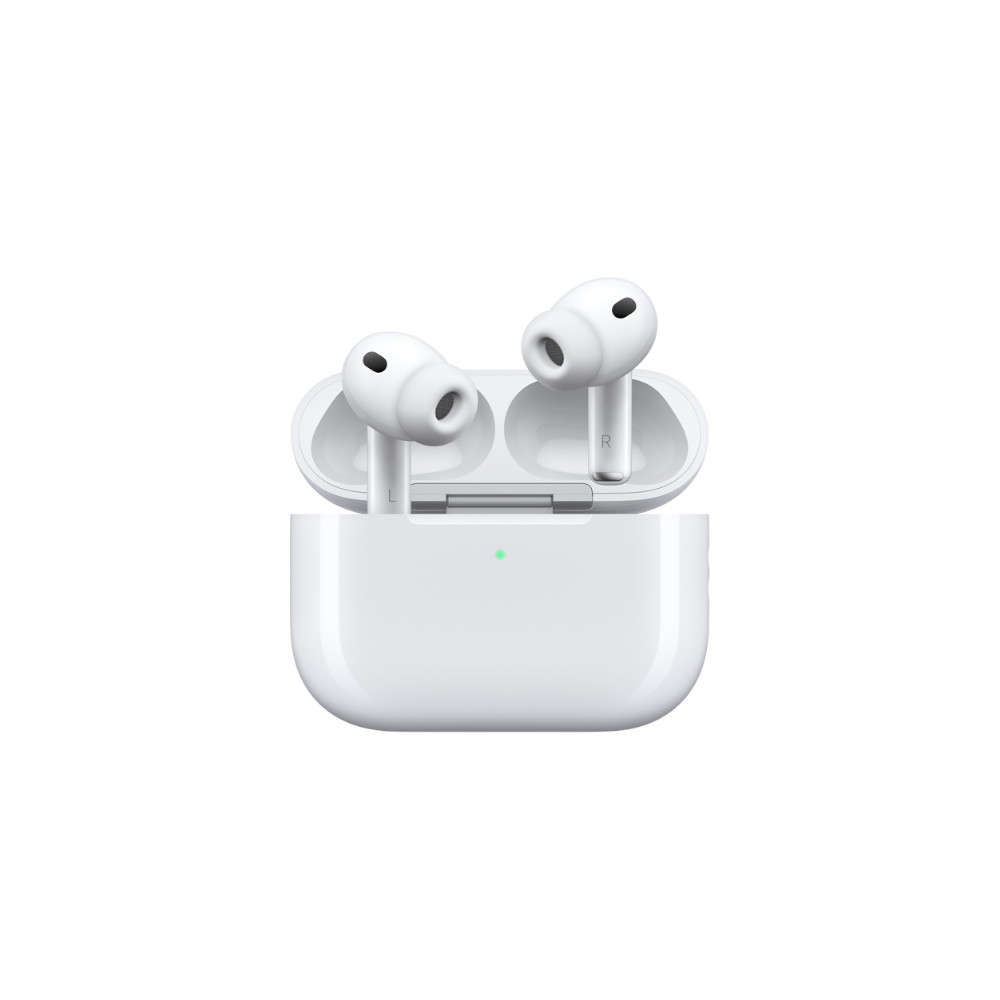


They might share the same white stems, but the AirPods Pro 3 and AirPods 4 are built for very different listeners. One delivers premium features like active noise cancelation and fitness tracking, while the other sticks to the basics with a more affordable, open-fit design. If you’re trying to figure out which AirPods are right for you, let’s break it all down in this AirPods Pro 3 vs AirPods 4 comparison.
This article was originally published on Sept 25th, 2025, and this is the first version.
What’s it like to use the AirPods Pro 3 compared to the AirPods 4?
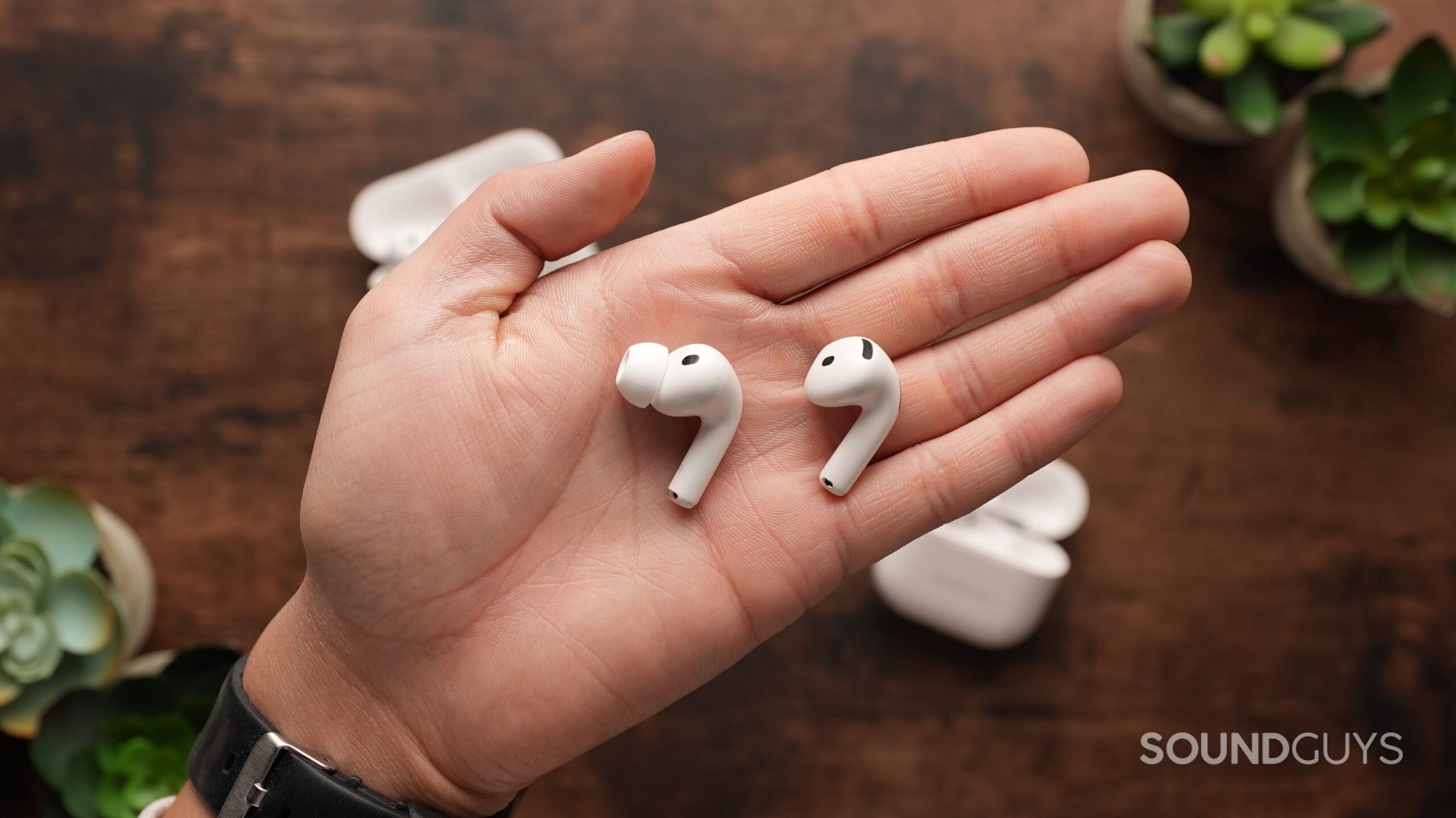
The AirPods Pro 3 and AirPods 4 offer dramatically different experiences, mainly due to their fit and form factor.
The AirPods Pro 3 use foam-infused silicone tips that create a sealed fit in your ears. This not only improves isolation and ANC performance, but also helps the earbuds stay put during workouts or commutes. In our testing, the Pro 3s fit securely for most people and came with five ear tip sizes to help dial in comfort. However, the glossy finish can make them a bit slippery when sweating heavily. Still, with an IP57 rating, these are better suited for active use and in the elements.
The AirPods 4, by contrast, stick to Apple’s classic open-ear approach—no ear tips, just hard plastic. This makes them feel lighter and more comfortable for some people, especially during casual wear or long listening sessions. But the one-size-fits-all design is hit or miss. Around our office, some folks found the new shape much improved over older AirPods, while others couldn’t get a secure fit at all. And because there’s no seal, they also don’t stay in place during exercise. The IP54 rating offers minor protection, but these aren’t built for intense activity.
If you value comfort over isolation and mainly listen in quiet environments, the AirPods 4 might be a better choice. But, if you need something that can handle movement, sweat, and block out the world, the AirPods Pro 3 clearly come out ahead.
| Action | Operation |
|---|---|
Single squeeze | Play/pause |
Double squeeze | Next track |
Triple queeze | Previous track |
Squeeze and hold (one earbud) | Listening mode toggle |
Squeeze and hold (both earbuds) | Live Translation |
Swipe up/down | Volume up/down |
| Action (stems) | Either earbud |
|---|---|
One tap | Play/pause |
Two taps | Skip forward |
Three taps | Previous track |
Press and hold | Siri |
"Hey Siri" | Change volume, request directions, playback control, receive messages, and more |
Nod or shake | Answer "yes" or "no" to Siri |
Do the AirPods Pro 3 or AirPods 4 have more features?
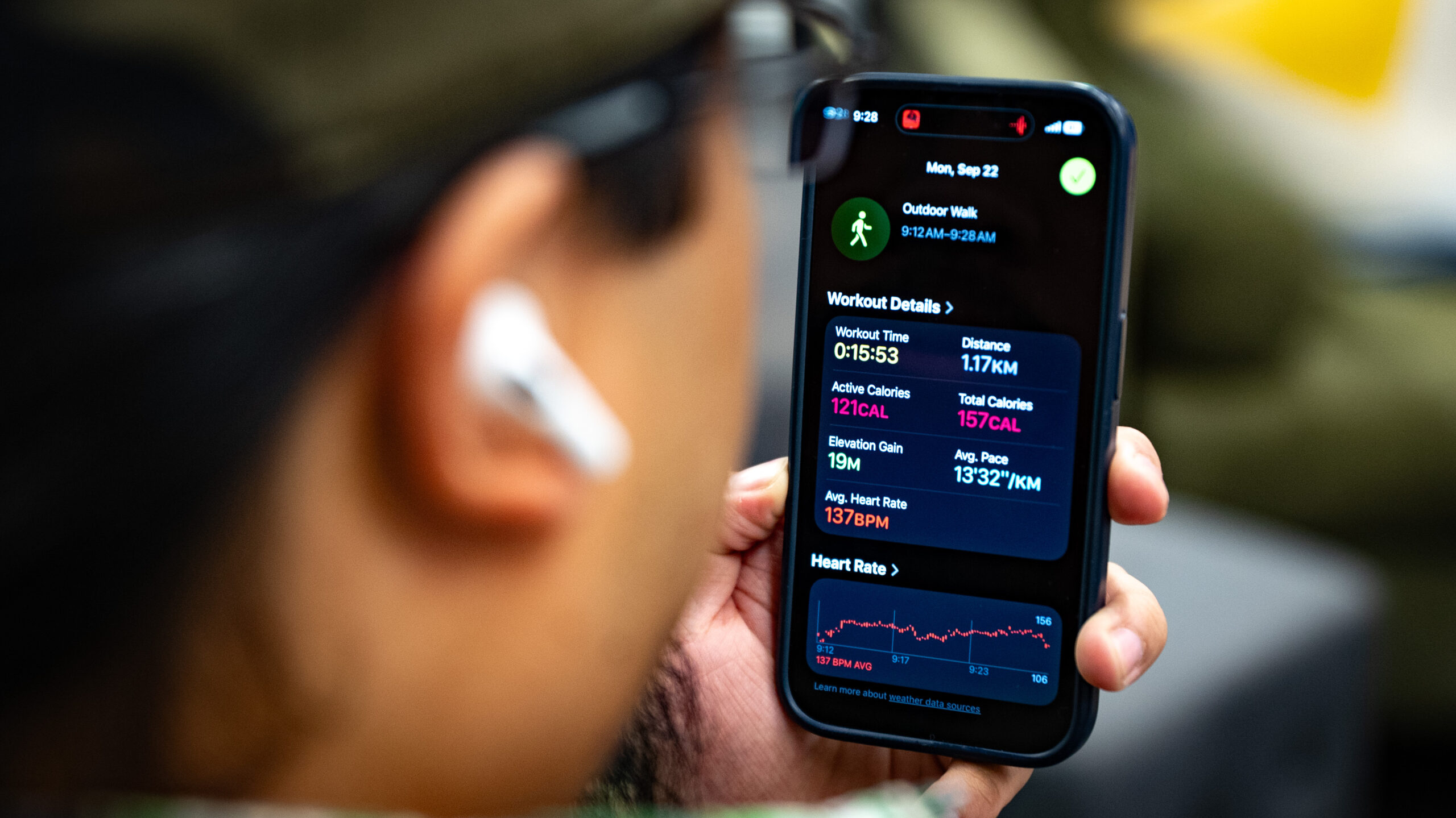
When it comes to raw features, the AirPods Pro 3 outpace the AirPods 4 by a wide margin.
The AirPods Pro 3 are Apple’s most advanced earbuds, with capabilities that extend beyond just music listening. You get heart rate monitoring, clinical-grade hearing assistance, and even real-time translation—features you won’t find on most competing earbuds. These tools live inside the Apple Health and Settings apps and work best for users fully committed to the Apple ecosystem. The Pro 3 also support Personalized Spatial Audio, Adaptive EQ, head gestures for Siri interaction, and a more customizable noise control interface.
The AirPods 4 offer a more stripped-down experience, though they still pack a few smart touches. You get the H2 chip for quick pairing, Spatial Audio with head tracking, Personalized Volume, and Conversation Awareness. A nod or shake of the head lets you interact with Siri nonverbally, which is fun but not essential. The new design also integrates with Apple’s Optimized Battery Charging to preserve long-term battery health. But there’s no ANC, no transparency mode, and none of the wellness features found in the Pro 3.
If you want earbuds that do more than just play music, the AirPods Pro 3 clearly take the crown. The AirPods 4 are best for users who want basic smart features with a more casual fit and a lower price tag.
How do the AirPods Pro 3 and AirPods 4 connect?

Both the AirPods Pro 3 and AirPods 4 use Apple’s H2 chip and Bluetooth 5.3, so they pair almost instantly, keep latency low, and switch between Apple devices without friction.
The AirPods Pro 3 go a step further with a U2 chip in the case. This enables ultra-precise Find My tracking, and during testing, I could pinpoint the case indoors using my iPhone’s on-screen directions. The AirPods 4 also pair quickly and switch reliably, but they lack the U2 chip, so tracking isn’t as accurate. Apple also swapped the physical pairing button for a touch-sensitive surface on the AirPods 4 case, which feels different if you’re used to older AirPods.
Both models use AAC for audio, which works consistently well on iPhones but offers less value on Android. Since most of Apple’s smart features rely on iOS, using either model outside the ecosystem strips them down to basic wireless earbuds. Overall, both stay rock-solid in daily use, but the AirPods Pro 3 stand out with their extra tracking tech.
Is battery life better on the AirPods Pro 3 or AirPods 4?
Battery life is another category where the AirPods Pro 3 edge out the AirPods 4.
In our standard playback test with ANC turned on, the AirPods Pro 3 delivered an impressive 8 hours and 42 minutes of continuous listening. Add in the case, and you’re looking at over 30 hours of total battery life. Fast charging is also excellent—just five minutes in the case gives about an hour of playback. You can charge the case via USB-C, MagSafe, Qi wireless charging, or even your Apple Watch charger, which adds a ton of flexibility.
In our tests, the AirPods 4 lasted 6 hours and 21 minutes, which is solid for a pair of unsealed earbuds without ANC. With the case, you get a similar 30-hour total, but there are some limitations. The standard AirPods 4 case doesn’t support wireless charging—it’s USB-C only—and there’s no built-in speaker for Find My tracking like there is on the ANC model. Optimized Battery Charging is available on both, which helps extend battery longevity over time by learning your usage habits.
In everyday use, either pair should easily get you through a workday. However, for heavy listeners or frequent travelers, the longer runtime and more flexible charging options on the AirPods Pro 3 make them a better bet.
Do the AirPods Pro 3 or AirPods 4 block noise better?
Loading chart ...
There’s no contest here: the AirPods Pro 3 blow the AirPods 4 out of the water when it comes to noise blocking.
The AirPods Pro 3 combine effective active noise cancelation (ANC) with excellent passive isolation from their foam-infused silicone tips. In our lab testing, they reduced ambient noise by up to 90%, especially in low-frequency ranges like airplane engines or subway rumble. The foam tips seal the ear canal effectively, creating a quiet bubble even before ANC kicks in. Whether you’re commuting, flying, or just trying to focus, these are among the best noise canceling earbuds you can buy.
The AirPods 4, on the other hand, don’t offer any noise cancelation at all. Their open-fit design means there’s no ear canal seal to block environmental noise. You’ll hear pretty much everything going on around you—whether it’s helpful (like traffic awareness) or distracting (like chatty coworkers or a noisy café). Apple does include a feature called Personalized Volume, which adjusts playback based on ambient sound, but it doesn’t replace true ANC or even passive isolation.
If you prioritize quiet, the AirPods Pro 3 are the obvious choice. The AirPods 4 are better suited for quiet environments or people who want to stay aware of their surroundings at all times.
Do the AirPods Pro 3 sound better than the AirPods 4?
The AirPods Pro 3 sound noticeably better, thanks to their sealed fit and upgraded acoustic design. They deliver deeper bass and a fuller profile, making music more powerful and immersive, especially in genres like hip-hop, pop, and electronic.
The AirPods 4, on the other hand, simply can’t keep up in the low end. Their unsealed fit means you won’t hear much bass, though vocals and instruments still come through clearly. They’re fine for casual listening, but they lack the richness and depth of the Pro 3.
Both models support Apple’s Spatial Audio, but Dolby Atmos tracks are more engaging on the Pro 3, where the isolation preserves detail and immersion. If sound quality is your top concern, go with the Pro 3. If you just want something light and easy for everyday use, the AirPods 4 will still get the job done.
Multi-Dimensional Audio Quality Scores (MDAQS)
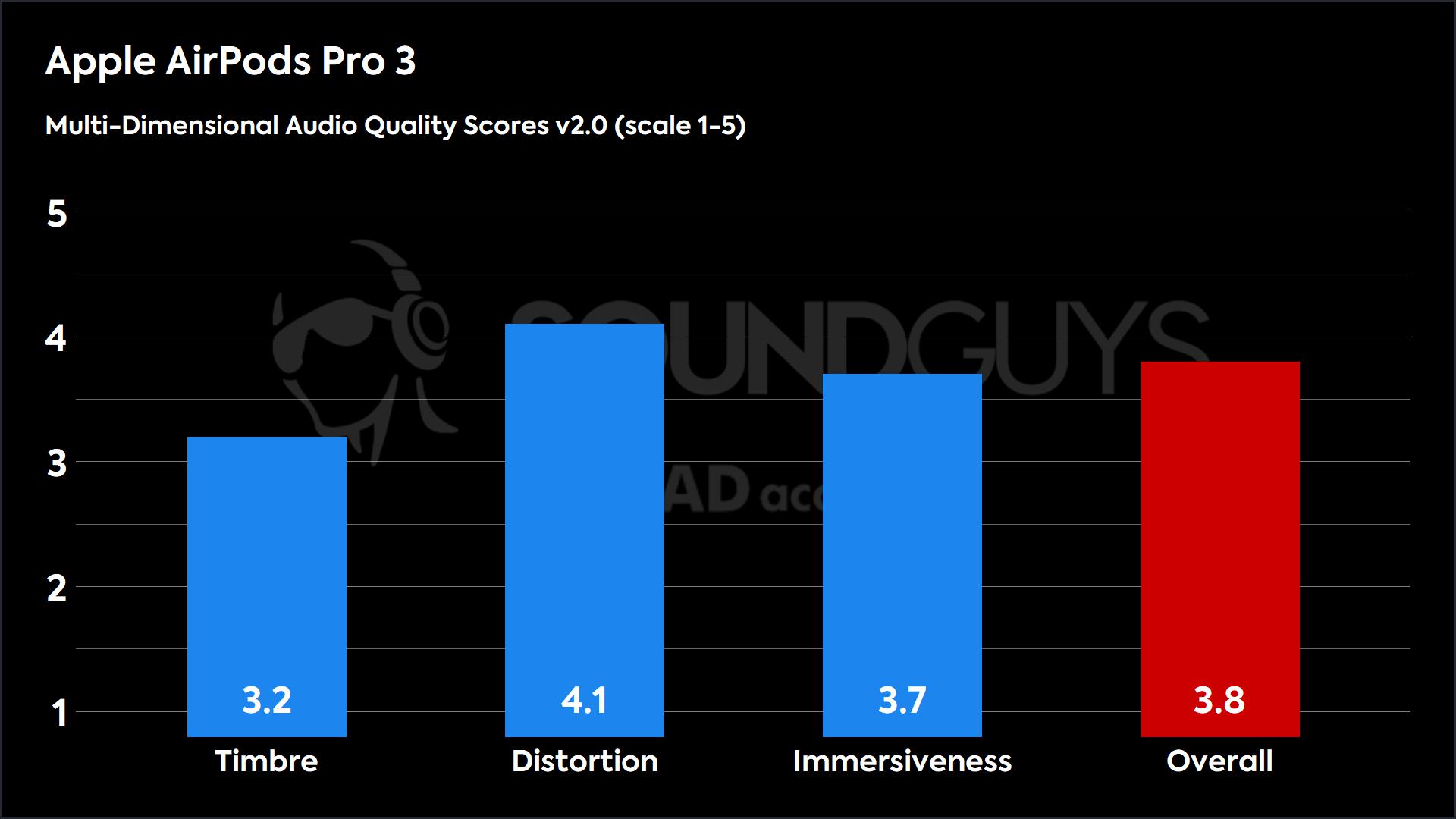
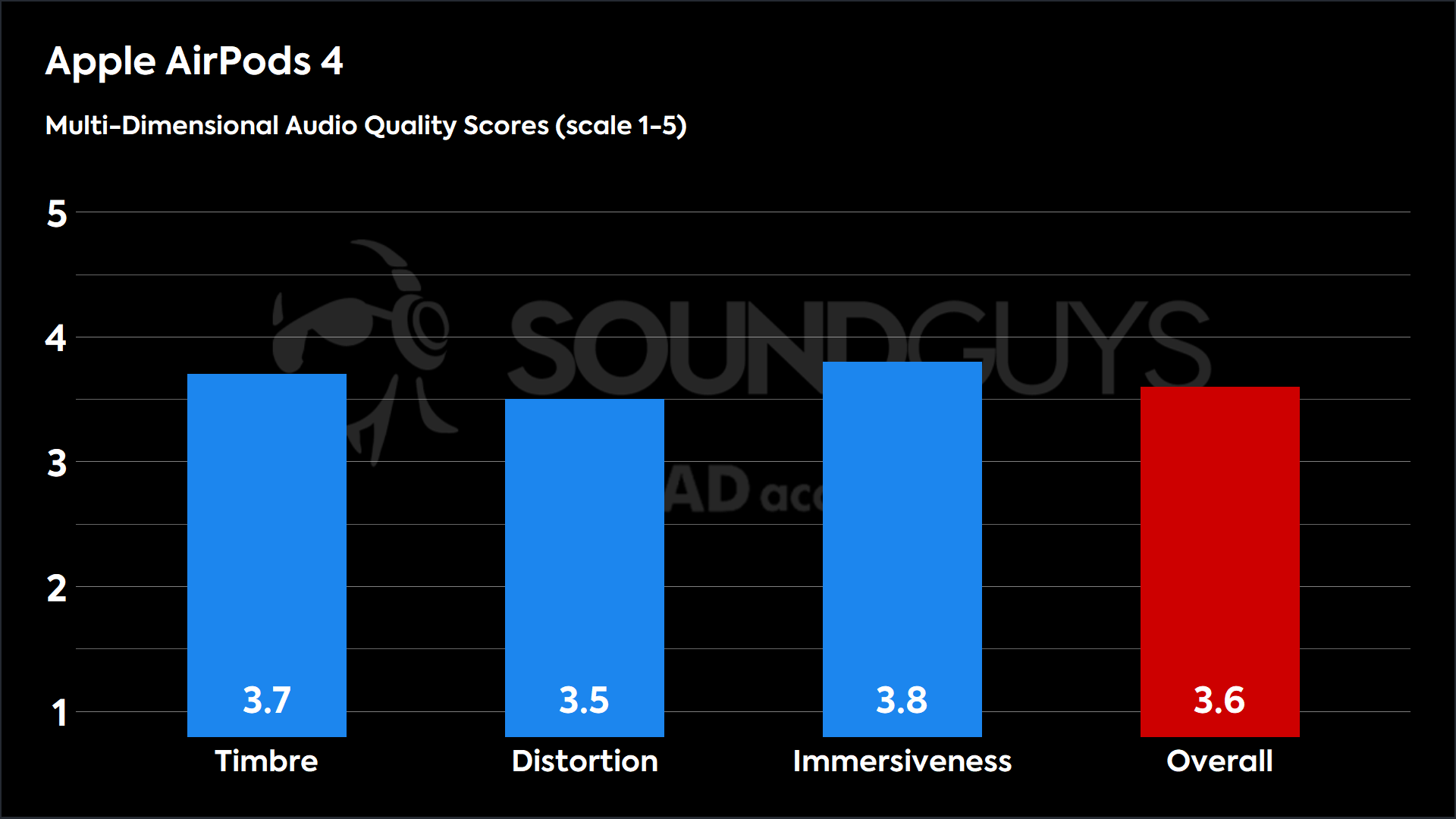
Hold up! Something’s different. The Multi-Dimensional Audio Quality Scores for the AirPods Pro 3 and AirPods 4 are not directly comparable due to a version difference between each reading. We’re still crunching the numbers on all of our previous samples to rectify this inconsistency soon.
- Timbre (MOS-T) represents how faithfully the headphones reproduce the frequency spectrum and temporal resolution (timing information).
- Distortion (MOS-D) represents non-linearities and added noise: higher scores mean cleaner reproduction.
- Immersiveness (MOS-I) represents perceived source width and positioning: how well virtual sound sources are defined in three-dimensional space.
Objective Measurements
Loading chart ...
In our testing, the AirPods Pro 3 were tricky to measure because of Apple’s Adaptive EQ system, so the frequency response chart should be read with some caution. Even so, their tuning follows our SoundGuys Headphone Preference Curve fairly closely through the lows and mids. The added emphasis below 100Hz gives the Pro 3 a richer, more bass-forward profile that listeners who enjoy extra punch will appreciate straight out of the box.
The AirPods 4 take a different approach. Their open-fit design simply can’t deliver the same low-end extension, which is why you’ll see a steep roll-off in the sub-bass region. This isn’t necessarily poor tuning—it’s the physics of an unsealed earbud. Still, they hold their own in the mids and highs, aligning well with our target curve and offering a clean, detailed sound if you don’t mind missing out on deep bass.
Do the AirPods Pro 3 or AirPods 4 have a better microphone?
Both earbuds offer solid mic quality, but the AirPods Pro 3 perform better overall. Voices sound fuller and more isolated, especially in noisy or outdoor environments. The AirPods 4 do well in quiet settings and support Spatial Audio on FaceTime, but struggle more with background noise. If you take calls on the go, the Pro 3 are the more reliable pick. Check out our microphone samples below to hear for yourself.
AirPods Pro 3 microphone demo (Ideal conditions):
AirPods 4 microphone demo (Ideal conditions):
AirPods Pro 3 microphone demo (COMPARISON conditions):
AirPods 4 microphone demo (COMPARISON conditions):
Which microphone sounds better to you?
AirPods Pro 3 vs AirPods 4: Price and availability
The AirPods Pro 3 retail for $249, making them Apple’s premium option. That price gets you strong ANC, fitness tracking, and hearing aid functionality—features that justify the cost if you’ll use them.
In contrast, the AirPods 4 cost just $129, making them the most affordable AirPods yet. You lose out on noise cancelation and wellness tools, but they deliver solid sound, strong iOS integration, and a lighter fit. If you’re looking for basic, reliable AirPods without breaking the bank, the 4s are a great entry point.
Should you get the AirPods Pro 3 or AirPods 4?
If you want the most capable AirPods Apple offers, the AirPods Pro 3 are worth the premium. You get excellent ANC, fuller sound, fitness features, and a more secure fit. They’re the go-to choice for travelers, commuters, or anyone who wants more than just basic earbuds.
The AirPods 4, meanwhile, are best for casual listeners who prioritize comfort and simplicity. They’re light, affordable, and sound good for their open design—but they lack noise isolation, making them less ideal for noisy environments.
Get the AirPods Pro 3 if you want powerful features and rich sound. Choose the AirPods 4 if you want a budget-friendly, open-fit experience that just works.
Otherwise, you can check out our list of the best wireless earbuds for even more options.
Which earbuds would you buy?
Thank you for being part of our community. Read our Comment Policy before posting.